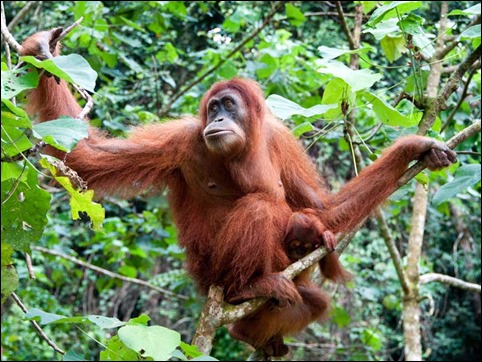The list of animals who researchers have seen using tools keeps growing. And by now, that’s no surprise. However, with Sumatran orangutans, who use sticks to eat honey, there’s a twist. It appears that scientists have only observed wild orangutans living West of the Alas River in Sumatrafishing for honey with sticks. We have never documented orangutans living east of the river using tools.
Genetic differences? Environmental factors? Scientists have basically ruled out these two explanations to explain tool use in some groups and not others. Now, researchers like Thibaud Gruber of the University of Zurich, argue that the explanation is strictly cognitive – meaning that the orangutans west of the Alas river are teaching their children to use the tool. One animal discovers a tool for a specific purpose and passes that knowledge on to others.
One animal discovers a tool for a specific purpose and passes that knowledge on to others.Scientists have documented this type of social learning among both captive-born and wild-born great apes living in captivity. But, until now, scientists have not been able to create an experiment that showed these abilities spreading through specific communal education methods. And the circumstances that enabled them to set up a scientific experiment are ironic and quite sad.
We are systematically destroying the native habitat of the orangutans. Deforestation, poachers, cattle ranchers, and palm oil plantations are the bane of orangutans in Sumatra. The Batu Mbelin Care Center in Northern Sumatra rescued some of the injured and orphaned orangutans from both sides of the Alas River. It is here that Dr. Gruber and his team have been able to test his social learning hypothesis.
 Researchers gave the orangutans two different tasks using sticks. In the first, dubbed the honey task, they gave the apes a vertical log and a leafless branch, and they were able to watch while one of the researchers poured honey into the log. Cue the orangutans and see what ensues. Nine out of the 13 orangutans from west of the Alas River successfully used the stick to retrieve the honey whereas only two of the ten apes from east of the river succeeded.
Researchers gave the orangutans two different tasks using sticks. In the first, dubbed the honey task, they gave the apes a vertical log and a leafless branch, and they were able to watch while one of the researchers poured honey into the log. Cue the orangutans and see what ensues. Nine out of the 13 orangutans from west of the Alas River successfully used the stick to retrieve the honey whereas only two of the ten apes from east of the river succeeded.
In the second test, called the raking task, the scientists placed food out of reach of the apes’ pens and offered them a curved stick and a straight one. In this case, while the orangutans from the west were more successful in using the sticks to retrieve the food, the rate was so statistically similar that the scientists concluded that the two groups were equally adept at using the sticks to reach the food.
Given these results, Gruber and his team argue that it is not genetics but social learning that is driving the honey-gathering stick behavior because both groups were so similar in ability in the raking test.
You can read more details about the tests at Science and at Scientific American, and the full study is published here, along with how the team ruled out all the other possible factors to arrive at their conclusions.
Time and more experiments will tell if orangutans’ acquired knowledge and culture are derived at, as Gruber says, “the representational level rather than the behavioral level.” Unfortunately, due to environmental factors, time may run out for wild orangutans from both East and West of the Alas River. And what this will do to their distinct cultures, nobody can say.
